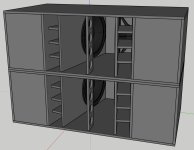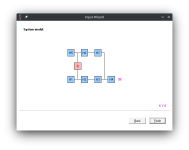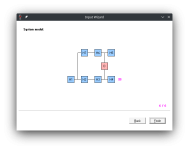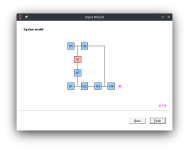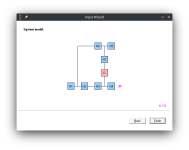Have you ever looked at a spectral analysis of the low A on a piano (or many of the common key sounds like clav or organ), or an open B string of a five string bass guitar? Basically zero fundamental on the case of the piano, and not a lot (relative to the second harmonic) of fundamental on the bass guitar.That's a concept I will never understand when a standard 88 key piano goes to 27.5hz.
Skip 6 mins in to this video to see C1 (32.7Hz) analysed, the fundamental is 20 or 40dB down on the first harmonic depending on the piano sampledHave you ever looked at a spectral analysis of the low A on a piano
They look like a similar offset driver horn with rear vented chamber. Really clever to make them as dual enclosures, so the driver can be mounted from the front, but compression ratio can be kept high.
The low tuned side looks like a steep tapered TL shape (fancy Bass reflex) inside with lots of bracing. We used to geek out in horn response looking at making that more of an ODTL or similar Big vented reflex (with strategic driver offset)
Last edited:
What plans are thoseI did a quick model of dual bins, where the drivers can be accessed from the front, without the need for an access door. Pretty sick looking!
After a bit of experimentation I came up with this.
As you probably can tell, very much inspired by Cain Duyts' designs.
Designed around B&C 12NDL76 4ohm
Drivers can be installed via the horn.
Tuned for SPL. I know it doesn't hit 40hz. That is by design. I am still running on battery power and need all the SPL and efficiency I can get. At lower SPL levels I can always plug one or two of the ports and adjust the DSP for a lower tune.
I have not added bracing yet.
Port air speed is a bit high at war levels, but I don't min a but of chuffing at this SPL level. Everything will be rattelling anyway. Again, everything in the name of SPL and efficiency in this design.
Do you guys think the ports going around a corner will be a problem at those high velocities?
There are probably a few mistakes in there, it's by no means a finished and polished design.
@LORDSANSUI your freeCAD software is amazing. Thanks!
As you probably can tell, very much inspired by Cain Duyts' designs.
Designed around B&C 12NDL76 4ohm
Drivers can be installed via the horn.
Tuned for SPL. I know it doesn't hit 40hz. That is by design. I am still running on battery power and need all the SPL and efficiency I can get. At lower SPL levels I can always plug one or two of the ports and adjust the DSP for a lower tune.
I have not added bracing yet.
Port air speed is a bit high at war levels, but I don't min a but of chuffing at this SPL level. Everything will be rattelling anyway. Again, everything in the name of SPL and efficiency in this design.
Do you guys think the ports going around a corner will be a problem at those high velocities?
There are probably a few mistakes in there, it's by no means a finished and polished design.
@LORDSANSUI your freeCAD software is amazing. Thanks!
Attachments
-
 Dual bin spreadsheet.JPG36.5 KB · Views: 14
Dual bin spreadsheet.JPG36.5 KB · Views: 14 -
 Dual bin.JPG24.1 KB · Views: 17
Dual bin.JPG24.1 KB · Views: 17 -
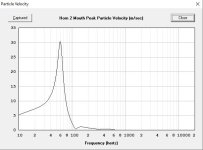 Dual bin port velocity max SPL.JPG31.1 KB · Views: 15
Dual bin port velocity max SPL.JPG31.1 KB · Views: 15 -
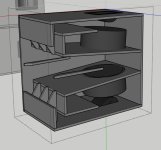 Dual bin open.JPG50 KB · Views: 19
Dual bin open.JPG50 KB · Views: 19 -
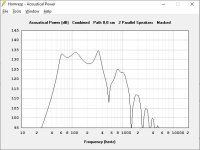 Dual bin max SPL.JPG42.1 KB · Views: 14
Dual bin max SPL.JPG42.1 KB · Views: 14 -
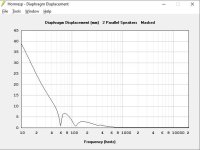 Dual bin max SPL displacement.JPG36.2 KB · Views: 12
Dual bin max SPL displacement.JPG36.2 KB · Views: 12 -
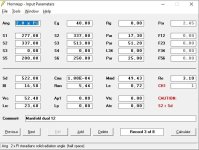 Dual bin hornresp.JPG53.8 KB · Views: 15
Dual bin hornresp.JPG53.8 KB · Views: 15 -
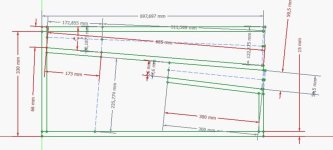 Dual bin blueprint.JPG44.9 KB · Views: 18
Dual bin blueprint.JPG44.9 KB · Views: 18 -
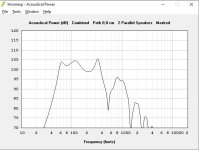 Dual bin 1w SPL.JPG40.2 KB · Views: 15
Dual bin 1w SPL.JPG40.2 KB · Views: 15
Port air speed is a bit high at war levels
Check the attachment in the post #172, it may give you some inspiration to reduce particle velocity at mouth. Just venture style, just one more peace of wood.
your freeCAD software is amazing
I'm happy you liked the tool.
Just be careful, the bend you introduced in the vent pointing it back to front chamber changed the model, it's not Compounded Horn anymore, now it became "Paraflex" and to improve accuracy you need to make some changes on it.
You can check other Paraflex model to understand how the model works, and adjust your self the models or ask for some help.
Attached you can find tome Praflex System Model to choose witch model fits better your needs now.
Attachments
Thanks for those ideas. I will mess around with that.Check the attachment in the post #172, it may give you some inspiration to reduce particle velocity at mouth. Just venture style, just one more peace of wood.
I'm happy you liked the tool.
Just be careful, the bend you introduced in the vent pointing it back to front chamber changed the model, it's not Compounded Horn anymore, now it became "Paraflex" and to improve accuracy you need to make some changes on it.
You can check other Paraflex model to understand how the model works, and adjust your self the models or ask for some help.
Attached you can find tome Praflex System Model to choose witch model fits better your needs now.
Do you really think that that slight change in port angle and placement will make a significant difference?
I guess a paraflex is a compound horn, where the low frequency horn fires into the high frequency horn? Well in this case the port fires into the very edge of the horn, so I guess it’s a grey area? Also I am not aware of a paraflex design that has a rear chamber?
Regarding the venturi port, I could probably just angle the panels, so that the corner becomes the narrow part, that would require no extra panels, just a slight headache of having strange shaped bracing. But would be cool if it worked.
Paraflex connects the resonator exits together and gives you that potential phase issue that seperating them a bit sort of avoids or dilutes out into the room ?
I wonder if connecting them together is more prone to ringing if they don’t both go into resonace at the same frequency (3 x Fb ) as you can see in horn response.
The longside is in resonance (velocity max at exit) , while the short side isn’t and the air is a bit contradictory at that point, the result might be so akward that it becomes audible. It’s obvious in a measurement either way
I wonder if connecting them together is more prone to ringing if they don’t both go into resonace at the same frequency (3 x Fb ) as you can see in horn response.
The longside is in resonance (velocity max at exit) , while the short side isn’t and the air is a bit contradictory at that point, the result might be so akward that it becomes audible. It’s obvious in a measurement either way
- Home
- Loudspeakers
- Subwoofers
- Case for Discussion - Would a Single driver Manifold/MTB be better than Tapped Horn?
